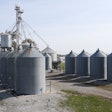
In 2014, the Unites States accounted for nearly 18 percent of global animal feed production, producing a total volume of 168 million tons*. Despite the drought in the West and disease in the swine herd, the commercial feed industry had a good year overall — up nearly 2 percent over 2013.
“[2014] was the first time that virtually every segment, in every species group, was not only a little bit profitable, but, in some cases, wildly profitable,” reports Clint Calk, commercial director for Cargill Animal Nutrition’s premix business. “There is no doubt that the use of disposable income and the shared economics of our customer base helped the industry. I think that is probably true for everybody.”
From improved consumer confidence to a record harvest, a number of factors drove growth in livestock feed manufacturing.
“In 2014 we saw moderation in prices of the various feedstuffs, and that provided more optimism about the recovery cycle for animal production,” explains David Fairfield, vice president of feed services, National Grain & Feed Association (NGFA), a trade group with 400 feed companies representing 78 percent of U.S. feed production. “While we’ve been through some difficult times in animal agriculture over the last five years, I feel like we’ve turned the corner and there’s a lot of optimism about the opportunities ahead.”
Given the positive upswing, it begs the question, what’s in store for the country’s 6,200* feed mills in 2015? Four of the nation’s largest animal feed companies provided their opinions on the trends, challenges and regulations that may influence animal feed industry and its productions volumes.
Will the growth trend continue in 2015?
Despite starting the year off on a high note, the following four major issues may play a role in either increasing — or decreasing — animal feed production in 2015.
1) The long-term impact of FDA animal feed regulations
Feed safety — and the regulations involved in ensuring it — will continue to be hot topics throughout the year. With the court-ordered release of the FDA’s final current good manufacturing practices (CGMP) and preventive controls rules for human food and animal feed due by August 30, and its final rule for foreign supplier verification programs by October 31, the industry is bracing for the next phase of Food Safety Modernization Act (FMSA) implementation.
Currently, the feed industry is operating in “one of the most complex regulatory environments we’ve ever seen.” As a result of the new requirements — and the costs associated with them — the playing field isn’t necessarily going to be an even one for all feed millers.
“Depending on how quickly [the FDA] pushes the feed industry to mimic the rules and regulations imposed on human food, many smaller companies may be forced out of business because they will not be able to compete profitably,” says Thomas Sigler, J.D. Heiskell & Co.’s California feed business manager.
“I think [FSMA] is going to play out significantly different across the feed industry and across our customer bases,” explains Tom Taylor, commercial director for Cargill Animal Nutrition’s U.S. compound feed business. “It’s a complicated program — and we should embrace it because it’s going to help us as an industry in the long term — but on the front end, I think it’s going to be a major challenge for some companies.”
2) Logistical challenges pose serious threat
One of the core issues for the feed and grain industries is rail transportation and strained capacity.
“[Rail transportation] is an active issue,” says Fairfield, NGFA. “We’ve done a lot of work with the Surface Transportation Board trying to establish better metrics to evaluate rail service provider performance and establish more effective means to deal with the various issues, such as service disruption. It’s a complicated issue.”
For example, according to Daren Kennett, SVP/founder, Hi-Pro Feeds, logistics posed a major challenge for Hi-Pro Feeds in 2014: “Most of our facilities are located on rail lines and in the southeast, southwest, south central United States, we rail in a lot of ingredients. However, with all the oil traffic from the Dakotas, there’s less engine power, fewer rail cars, available. It has impacted our ability to get ingredients shipped in by rail.”
Feed producers have mainly dealt with this challenge in two ways: storing more commodities, and shipping ingredients using a combination of truck and rail.
Production is only half the equation; the ability to deliver it in a timely manner is of the utmost importance. However, trucking has challenges of its own.
According to Jim Moore, vice president and GMM, feed division, Southern States Cooperative (SSC), “The world of trucking right now is not friendly to anyone.”
“Changes in DOT regulations over the last few years pushed a lot of people out of the trucking industry,” Moore explains. “There simply aren’t as many truckers available. In today’s world, for every truck out there, you have multiple loads waiting to be hauled. The truckers have leverage, and they’re picking and choosing what they want to do.”
3) Regional conditions dictate production capacity
Though volumes were up in 2014, feed demand varied from region to region. From a geographic perspective, the truth is that feed production went “where the animals were.” While some mills could have used additional production capacity, others had excess.
“In some locations, we could make more feed, and in other places we couldn’t make another ton,” explains Kennett, Hi-Pro Feeds. “Overall, we still have capacity to make more feed, but I would be reluctant to say how much more — sometimes it might be a case of ‘we’ll figure it out’ by adding shifts or an extra day of production.”
Cargill’s Taylor agrees: “If you look at our overall capacity, we have pockets of the United States that needed additional capacity, other areas didn’t. As livestock and consumer patterns shifted regionally, it did provide additional opportunities for us.”
Naturally, weather conditions — inclement or favorable — are apt to play a significant role in influencing this trend.
4) Added investment, added efficiency
Millers have also started putting more money toward improving the internal workings of the feed mill. Equipment and software upgrade were noted as strategies for both improving feed quality and cost-effectively increasing production.
“[J.D. Heiskell & Co.] is trying to grow its facilities as well,” says Dave Nuss, J.D. Heiskell & Co. sales manager. “We’re adding space and adding equipment to try to expand with the industry and up the amount of business we’re able to commit to.”
Moving forward
From an economic standpoint there’s a lot of optimism among animal agriculture and feed manufacturers alike.
“Everyone talks about population growth and the growing middle class and the demand for animal-based protein; there are many opportunities for U.S.-based operations to move forward,” Fairfield reports.
Based on these factors, the outlook for 2015 is a positive one.
“I would expect to see continued growth as we move forward,” Taylor predicts. “There are sectors where that might not be the case, but we still expect to see growth [this] year.”
*Source : AFIA

















